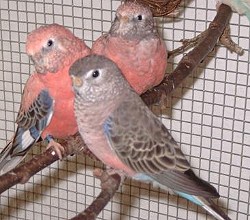
Bourke's parrot, orBourke'sparakeet, orBourke(Neopsephotus bourkii)
Phylum —chordata
Class — aves
Order — psittaciformes
Family — psittaculidae
Genus – neopsephotus
Appearance
The Bourke's parrot is a relatively small species. They tend to vary between 18 cm and 23 cm in length with a tail length of approximately 9 cm. The females of the species tend to be slightly smaller than the males: males of the species weigh between 47 g and 49 g whilst females weigh between 41 g and 49 g. Both sexes look very similar until the age of nine months, after which they come into full plumage color. In the wild, Bourke's parakeets display an overall brown coloration with a pink abdomen, pinkish breast and a blue rump. The legs are dark-brown, with zygodactyl toes. The bill is yellowish-brown. The adult male has a blue forehead while the adult female has a little or no blue on the forehead. The Bourke's parrot's feathers help it blend in with the reddish soil of its arid home.
Habitat
The Bourke's parrot is native to Australia.
Behavior
These parrots are usually found on the ground, although they are also considered to be arboreal. While on the ground, they are easily camouflaged since their plumage blends in with the reddish, sandy soil in mulga steppes.
Usually, these parrots are found in groups of four to six. They may be found in flocks of approximately 100 birds, especially during drought conditions. While in these large groups they will visit watering holes at dawn or dusk. Local populations may stay in the same vicinity for many years, then move to another area. Bourke's parrots are considered to be sedentary and nomadic.
Bourke's parrots feed and drink at dawn and dusk. They do not mate or attend to nestlings at or before sunrise or sunset so are not considered to be truly crepuscular. On moonlit nights, these parrots may be active the entire night.
Bourke's parrots enjoy rain baths, but male and female pairs do not engage in mutual preening.
Diet
Bourke's parrots forage on the ground and in bushes for grasses and seeds.
Reproduction
During the nesting season, males are highly territorial, chasing away any potential intruders or threats. Breeding season for the Bourke's parrot usually occurs between the months of August and October, but can also draw out into December, depending on the season and availability of resources.
Bourke's parrots are monogamous, staying with a single partner. Their nests tend to be situated from 1 meter to 3 meters above ground level in hollow limbs of the mulga tree or other acacia species. Eggs are generally laid on a bed of decayed wood at the bottom of the tree hollow. The Bourke's parrot has a clutch of 3 to 6 eggs, which are incubated by the female for 18–19 days. During this period, she is fed by the male parrot, only leaving the nest to find water or to defecate.
Once the chicks hatch, both parents feed their young. Offspring begin fledging at about 4 weeks of age, becoming fully independent around 8 to 10 days later.
In captivity
This species has a lifespan of 10 to 12 years or more with good care.
These birds are enthusiastic flyers, so they are better suited for roomy aviaries rather than cages. A suitable aviary is at least 6 feet in length with several tree branches for the birds to climb.If an aviary is not a practical possibility, choose the largest cage possible, with dimensions that are wider than they are tall, as these birds enjoy horizontal flight. A cage should be at least three feet long, 1 1/2 feet wide, and 1 1/2 feet tall. This bird is best suited caged with another Bourke's parakeet; although they can live well on their own. If kept single, interact with it daily to curb loneliness. Swings are an excellent addition to an aviary or cage.
Bourke's parakeets are enthusiastic bathers, so make sure to keep bathing pools inside the cage or aviary. Make sure the bathing water is fresh and clean. You can also spray the bird with lukewarm water for an enjoyable activity for the bird.
Parakeets are incredibly social birds, and Bourke's parakeet is no exception. Although less demanding than some other species, your bird needs at least two hours of interaction and training each day.
Bourke's parakeets are less active than most other parakeets but still need between 2 to 3 hours outside of the cage daily in a supervised play area. These birds like long horizontal flights, so provide a safe flying environment—free of other animals, ceiling fans, and open doors or windows.
Your Bourke's parakeet will enjoy plenty of toys. Offer commercial plastic toys with bells and bright colors and everyday household items to gnaw on, such as cardboard egg cartons.
A Bourke's parakeet in captivity needs a balanced meal daily. This bird will eat up to a tablespoon of small parrot seed mix meant for Budgies and birds of similar size and a variety of fresh vegetables and fruits.
 Russian
Russian
 English
English























